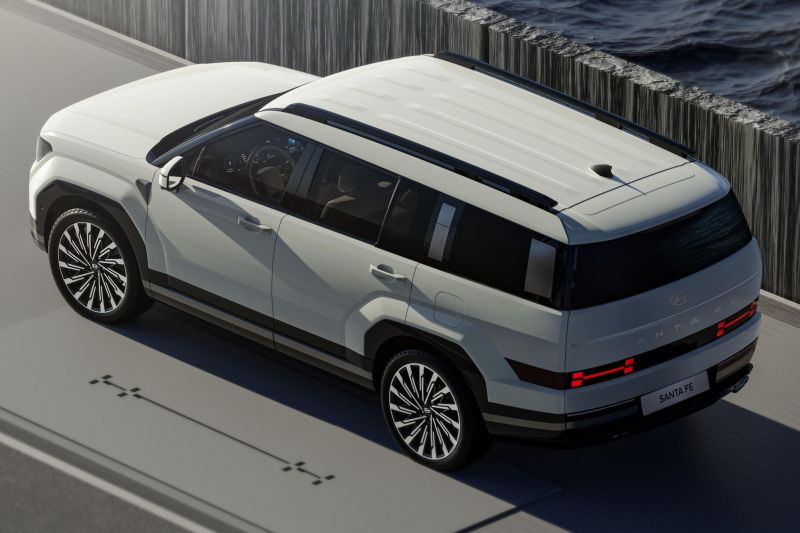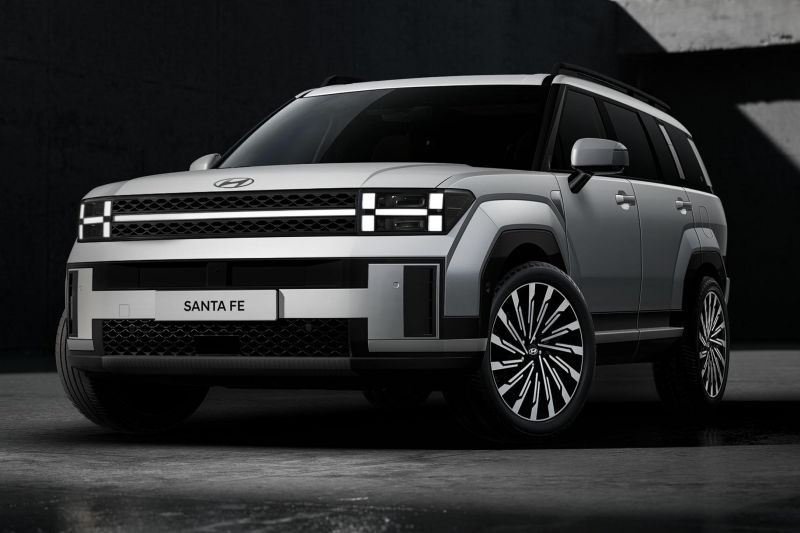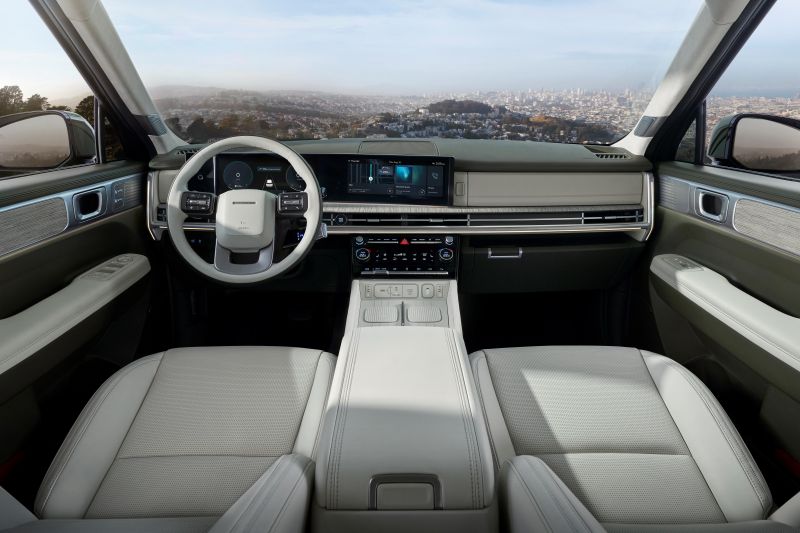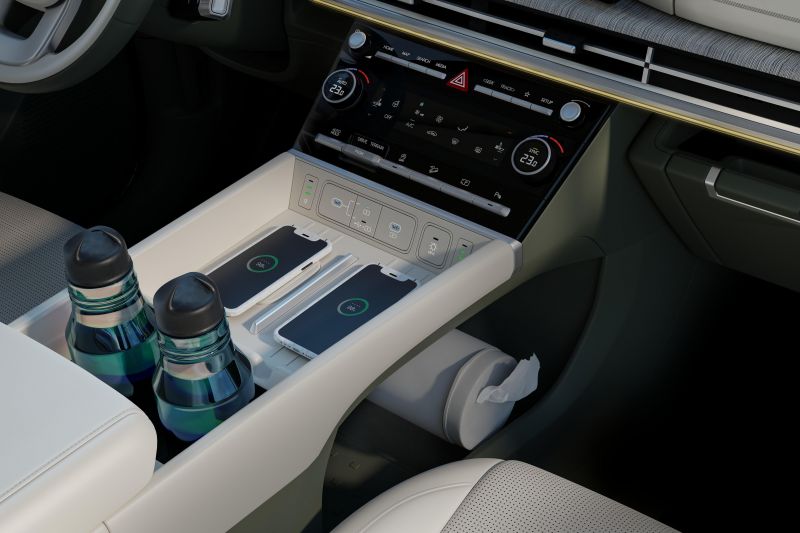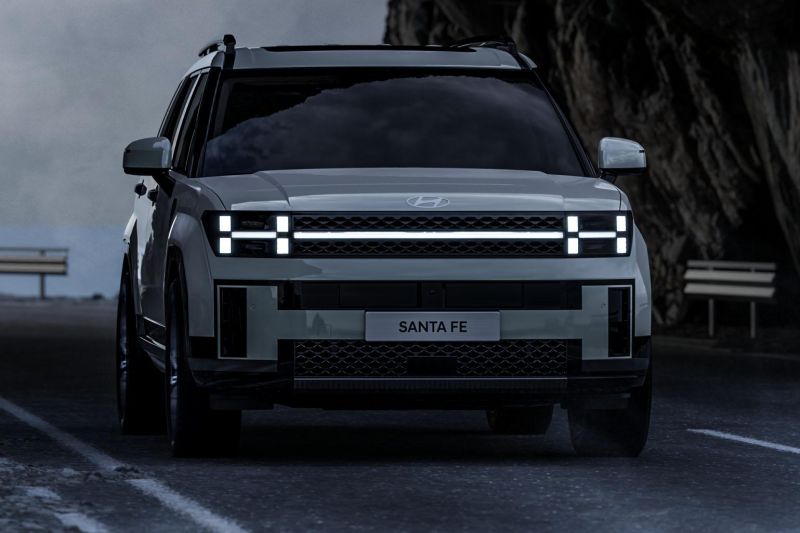Hyundai’s design team first showed the upcoming Santa Fe to management with square wheels to make a point.
That’s what Hyundai exterior design manager Nicola Danza told Top Gear, saying he worked to excise any sporty design elements from the upcoming fifth generation of the brand’s long-running large crossover.
“In this segment we realised that all the cars tended to look the same,” Mr Danza told Top Gear.
“They’re all slanted and trying somehow to be a sporty SUV that they’re not. They’re big, they’re huge. How many blisters can you put on the body side to pretend that you’re sporty?
“In this case we said let’s try to make an anti-design car. Strange words for a designer but at the same time it was about making it really pure. We wanted it to be more practical, and more practical means boxier, so let’s make boxy cool again.
“We forced the designers to really think whether they needed each line and each blister. It was kind of like a Giugiaro way of designing cars from the 1970s.”
That led to the design team showing the first model of the car to management with square wheels as, in Mr Danza’s words, “it’s a box, so let’s make everything boxy”.
While some have compared the Santa Fe’s looks to that of the third-generation Land Rover Discovery, Mr Danza says the final product instead reminds him of the first Jeep Grand Wagoneer with more of a “raised station wagon” look.
The new Santa Fe is the latest chapter in Hyundai’s current era of design, which has seen it roll out a range of varied designs – from the swoopy Ioniq 6 ‘streamliner’, to the retro hatchback-esque Ioniq 5, futuristic Staria, and creased Tucson.
Its boxy lines don’t resemble any other Hyundai at the moment, except perhaps the flagship Palisade – if you squint, perhaps.
“As designers it’s a dream working at Hyundai at the moment,” said Mr Danza.
“You can experiment, you can try different things, you can challenge. You need to keep us motivated; we are creative people. If you don’t feed creativity it tends to die or make it more boring and normal.”
Hyundai is far from the only company introducing a boxy SUV. This style is enjoying a resurgence among Chinese automakers, led by models like the GWM Tank 300, while the upcoming Toyota LandCruiser Prado arguably looks more like a Land Rover Defender than the outgoing model with its bluff lines.
The new Santa Fe is due in Australia in the first half of 2024.
At 4830mm long and 1900mm wide, the new Santa Fe is 55mm longer than the SUV it replaces but the same width. The 2815mm wheelbase is 50mm longer than before, which should help free up more legroom for rear passengers.
Claimed boot space is 725 litres with the second row in place, up 91L on the car it replaces.
Interior space has been improved across the board courtesy of the larger exterior, longer wheelbase, and boxier design.
Hyundai claims the second and third rows both feature more legroom than before (up 20mm and 15mm respectively), and says there’s now 69mm more headroom in the rearmost seats. The third row also now reclines further.
The exterior’s boxy theme is carried over into the interior, which mixes straight lines with soft-touch leather-like surfaces.
A large curved rectangular slab houses a 12.3-inch digital instrument cluster and a 12.3-inch infotainment touchscreen. There’s also a 6.6-inch climate touchscreen display, and a digital rear-view mirror that uses a camera to project a live feed of what’s behind the car.
The gear shifter has been moved to the column, and the centre console instead features two wireless smartphone charging pads, two 27W USB-C ports, two oversized cupholders, and an open-air storage underneath.
In South Korea and the USA, the Santa Fe will be available with two engines. The entry-level is a 2.5-litre turbocharged petrol four-cylinder making 207kW and 422Nm.
It’s mated with an eight-speed dual-clutch automatic, and claimed fuel economy is 9.0L/100km.
Also available will be a hybrid, which mates a 1.6-litre turbocharged petrol four-cylinder engine with an electric motor and a six-speed automatic transmission.
The maximum engine outputs are 132kW and 265Nm, but Hyundai hasn’t detailed how much it makes in tandem with the electric motor. Claimed fuel economy is 6.5L/100km.
The current Santa Fe hybrid has a very similar powertrain, and is good for 169kW and 350Nm.
A plug-in hybrid will be offered in Europe, and a non-turbocharged petrol will be offered in some corners of the world – but we’re expecting to see the 2.5-litre turbo and the 1.6-litre hybrid in Australia.
Notable is the death of diesel: this is the first Santa Fe to be sold without a diesel engine option.

